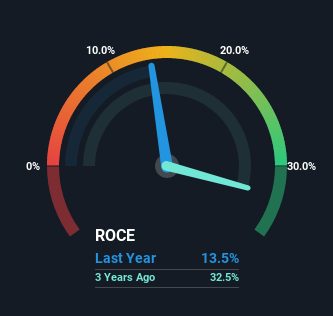- Malaysia
- /
- Electronic Equipment and Components
- /
- KLSE:ATECH
Here's What's Concerning About Aurelius Technologies Berhad's (KLSE:ATECH) Returns On Capital
If you're looking for a multi-bagger, there's a few things to keep an eye out for. One common approach is to try and find a company with returns on capital employed (ROCE) that are increasing, in conjunction with a growing amount of capital employed. Basically this means that a company has profitable initiatives that it can continue to reinvest in, which is a trait of a compounding machine. Although, when we looked at Aurelius Technologies Berhad (KLSE:ATECH), it didn't seem to tick all of these boxes.
Return On Capital Employed (ROCE): What Is It?
Just to clarify if you're unsure, ROCE is a metric for evaluating how much pre-tax income (in percentage terms) a company earns on the capital invested in its business. The formula for this calculation on Aurelius Technologies Berhad is:
Return on Capital Employed = Earnings Before Interest and Tax (EBIT) ÷ (Total Assets - Current Liabilities)
0.14 = RM34m ÷ (RM437m - RM188m) (Based on the trailing twelve months to October 2022).
Therefore, Aurelius Technologies Berhad has an ROCE of 14%. In absolute terms, that's a pretty standard return but compared to the Electronic industry average it falls behind.
Check out our latest analysis for Aurelius Technologies Berhad

Above you can see how the current ROCE for Aurelius Technologies Berhad compares to its prior returns on capital, but there's only so much you can tell from the past. If you'd like, you can check out the forecasts from the analysts covering Aurelius Technologies Berhad here for free.
How Are Returns Trending?
On the surface, the trend of ROCE at Aurelius Technologies Berhad doesn't inspire confidence. Over the last three years, returns on capital have decreased to 14% from 33% three years ago. However, given capital employed and revenue have both increased it appears that the business is currently pursuing growth, at the consequence of short term returns. If these investments prove successful, this can bode very well for long term stock performance.
On a related note, Aurelius Technologies Berhad has decreased its current liabilities to 43% of total assets. That could partly explain why the ROCE has dropped. What's more, this can reduce some aspects of risk to the business because now the company's suppliers or short-term creditors are funding less of its operations. Some would claim this reduces the business' efficiency at generating ROCE since it is now funding more of the operations with its own money. Either way, they're still at a pretty high level, so we'd like to see them fall further if possible.
What We Can Learn From Aurelius Technologies Berhad's ROCE
Even though returns on capital have fallen in the short term, we find it promising that revenue and capital employed have both increased for Aurelius Technologies Berhad. And the stock has followed suit returning a meaningful 73% to shareholders over the last year. So while the underlying trends could already be accounted for by investors, we still think this stock is worth looking into further.
Aurelius Technologies Berhad does have some risks though, and we've spotted 1 warning sign for Aurelius Technologies Berhad that you might be interested in.
If you want to search for solid companies with great earnings, check out this free list of companies with good balance sheets and impressive returns on equity.
The New Payments ETF Is Live on NASDAQ:
Money is moving to real-time rails, and a newly listed ETF now gives investors direct exposure. Fast settlement. Institutional custody. Simple access.
Explore how this launch could reshape portfolios
Sponsored ContentNew: Manage All Your Stock Portfolios in One Place
We've created the ultimate portfolio companion for stock investors, and it's free.
• Connect an unlimited number of Portfolios and see your total in one currency
• Be alerted to new Warning Signs or Risks via email or mobile
• Track the Fair Value of your stocks
Have feedback on this article? Concerned about the content? Get in touch with us directly. Alternatively, email editorial-team (at) simplywallst.com.
This article by Simply Wall St is general in nature. We provide commentary based on historical data and analyst forecasts only using an unbiased methodology and our articles are not intended to be financial advice. It does not constitute a recommendation to buy or sell any stock, and does not take account of your objectives, or your financial situation. We aim to bring you long-term focused analysis driven by fundamental data. Note that our analysis may not factor in the latest price-sensitive company announcements or qualitative material. Simply Wall St has no position in any stocks mentioned.
About KLSE:ATECH
Aurelius Technologies Berhad
An investment holding company, offers electronic manufacturing services for industrial electronic products.
Flawless balance sheet with solid track record.
Similar Companies
Market Insights
Weekly Picks

THE KINGDOM OF BROWN GOODS: WHY MGPI IS BEING CRUSHED BY INVENTORY & PRIMED FOR RESURRECTION


Why Vertical Aerospace (NYSE: EVTL) is Worth Possibly Over 13x its Current Price


The Quiet Giant That Became AI’s Power Grid
Recently Updated Narratives


A case for USD $14.81 per share based on book value. Be warned, this is a micro-cap dependent on a single mine.

Occidental Petroleum to Become Fairly Priced at $68.29 According to Future Projections

Agfa-Gevaert is a digital and materials turnaround opportunity, with growth potential in ZIRFON, but carrying legacy risks.
Popular Narratives


MicroVision will explode future revenue by 380.37% with a vision towards success


Crazy Undervalued 42 Baggers Silver Play (Active & Running Mine)





